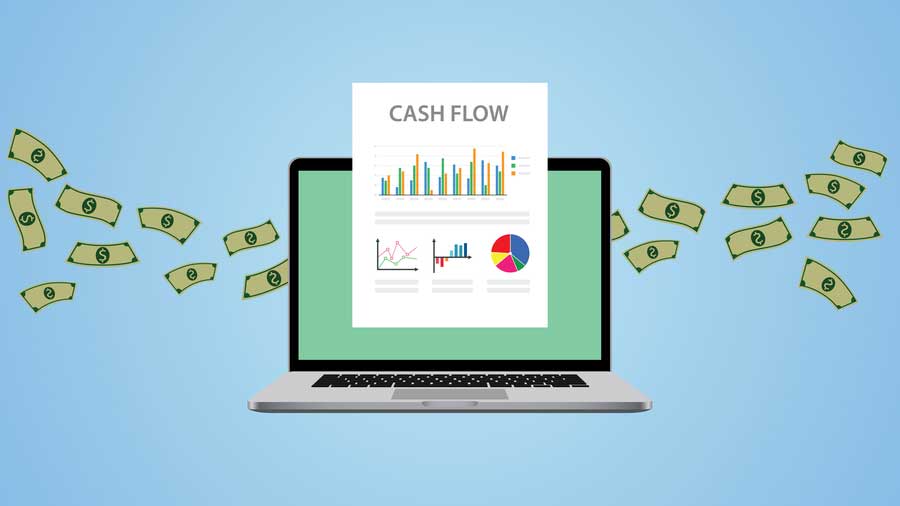Optimize Business Cash Flow: Everything You Ever Wanted to Know But Were Too Afraid to Ask

Article Summary: Optimal cash flow is one of the most important measurements tools business owners use to evaluate the state of their business. Here is a comprehensive list of best practices and most definitely don’ts to optimize business cash flow.
Best Practices
- A Weekly Cash Flow Journal While You’re Learning the Ropes
- Treating Cash as Three Different Revenue Sources
- Create a Great Cash flow Environment
Most Definitely Don’ts
- The Road to Hell is Paved with Good Intentions
- Robbing Peter to Pay Paul
Small business is filled with big stories. Every owner has the “catching the biggest fish” story and the “business near death” story where victory was snatched out of the jaws of defeat at nearly the last minute. If you look behind the scenes of these stories you’ll see that every story ends with this point: you need to optimize business cash flow to survive.
Any one-on-one conversation between small business owners moves from talk of a variety of amazing achievements to the sticky situations that they have gotten themselves into while working on their amazing achievement. Underneath this storytelling is an axiom that cash is king. Yes, in small business, the more cash you have, the less vulnerable you are and thus, the more powerful you feel. You can be the smart person who can take advantage of the buyer’s market or purchasing bulk inventory at a particularly favorable price to offset your cost of goods sold for the next quarter if you are flush and optimize business cash flow.
Being flush is the best feeling in the world for a small business owner. Why? Because having enough cash in the bank to float the business “rain or shine” in “good times and bad” and all of these other cliched sayings is the way to have the freedom that we all sought when we started our small businesses. When you have cash, you can feel good natured or generous even if your largest customer is late in paying their big bill, it gives you the confidence that you can continue operating in a manner that feels more comfortable than hustling and living on the possibility that tomorrow you’ll be able to sell more than you did today. Being flush is the source of delicious and deep sleep something that might have evaded entrepreneurs since starting their businesses.
Having a clear set of best practices around how you manage your cash will help you create stable margins in your business which breeds predictability, a cushion of cash and the freedom to grow your business. When you manage your accounts properly, you will be able to predict your inflows and outflows which is key to business performance. Your cash management capabilities impact every aspect of your business. Let’s take a look at cash flow management best practices that will help you gain control, confidence and margin stability in your business.
Best Practice #1: Optimize Business Cash Flow with a Cash Flow Journal
Starting a business means learning how cash flows into and out of the business. Using a weekly cash flow journal is the simplest way to learn about the burgeoning patterns of cash flows. You can easily do this journal with a pencil and a preprinted calendar, set up a notebook specifically for this task or use an excel spreadsheet that you make.
In your journal, record details on the revenues you receive daily, including which customers paid you, for what items/services, and if it was a recurring or one-time payment. Then record your daily expenditures—what bills have you paid, what they are for and if they are a one-time or recurring payment.
At the end of the day, add up your revenues and reduce the number by your expenses to get your daily cash flow numbers. If you have a business with lots of transactions like an ice cream shop or restaurant, you can batch these transactions by income stream—for example: make an income line item for in-store sales, wine or beverage sales, and a line item for wholesale revenues (i.e. for selling ice cream to restaurants).
This will help you understand how cash is moving in and out of your business —the ebbs and flows of your daily activities. From this place, you are able to tweak and tune your target metrics for sales, and track the net cash you’re able to take away at the end of the day. In short, by using a cash flow journal you can start to optimize business cash flow by tracking what kinds of sales results you are producing, what kinds of expenses you are racking up, what days are the most busy for sales and the frequency in which you’re paying out money.
This kind of activity has you, the business owner, start generating the numbers for your first metric called in short hand, “the acid test.” The acid test helps you understand the ratio between current assets and current liabilities. Your goal is a “high liquidity” business, which means that you’re able to pull cash to cover unexpected expenses, or buy materials if you find a great deal. In general, a business is “high liquidity” if your income is at least twice that of your liabilities. That is the metric that will make you feel confident that you’ll be able to consistently pay your bills. The journey from newbie to becoming a crackerjack with cash is the first great journey an entrepreneur takes. In becoming masterful, you are taking the cash journal from an intellectual exercise and making it an action that becomes second nature. This will have you become a pro at making cash king in your business in no time.
Best Practice #2: Treating Cash as Three Different Revenue Sources
Cash is cash is cash, right? Well, let’s unpack this. Thinking that there is more than one kind of cash will have you treating your cash flow differently. Treating your cash differently will change your relationship to the cash that comes in and make it easier to optimize business cash flow.
First, there is operating capital. This is the money that you need now to keep your business running. This is the kind of cash you make payroll with and buy materials with—this cash is the basic and essential use for cash. Then there’s financing capital which you want to set aside for growing the business. You need cash for things like a down payment for equipment or buying a building. Then there is R&D money—the money that you need to develop new products and services. Too often entrepreneurs try to fuel their R&D efforts from the same pool of operating capital that keeps the business afloat. This is a sure way to short change your R&D because as we all know, operations will need more or less money to keep operating dependent upon growth.
If you tag the cash that comes into your business for different purposes, you will segment that capital in a manner that helps you set aside money for the things you want—almost like a vacation savings account you can get at a bank. Harry Lowenstein, my SCORE mentor in NYC, told me this ditty, “every dollar has a job.” So true, so true Harry! If I have money that I’m not certain what to do with, I’ll spend it somewhere on something that later on, I’ve mostly come to regret. When every dollar has a job, every dollar is assigned to a line item or budget item, ensuring that you’re funding the things that you want rather than spending on things that you don’t want in the long run.
Best Practice #3: Create a Great Cash Flow Environment
Most startup entrepreneurs have to learn the ropes to creating an environment that has customers pay fast and on time. A rookie mistake that so many new business owners make is starting out offering terms when they need cash and sales the most. Most of these startups can’t afford to offer terms. This leads automatically to a precarious cashflow situation and many sleepless nights. So how do small business owners set up the rules of engagement? Small business owners must create the pathway for customers to know how to pay. Different conventions for different industries help illuminate a way that payments are made and accepted.
Let’s think about that restaurant example again—diners come in and order their meals and receive a check at the table when they’re finished with their dining experience—the waitperson gets a check ready, hands it off to the diner and is ready for payment. Most diners know this convention. The same restaurant might do big catering. A sizable deposit is expected for a large catering. A caterer asking for a deposit is part of the convention that this industry dictates and meets the expectation of the client. The caterer might take checks, credit cards, cash, or online payments to make payments easy for clients. These familiar patterns make customers feel comfortable with paying at least a portion upfront. The right environment tells your clients how they are going to pay for your products or services—and this is key to your business model working and the conditions for your cash flows.
We’ve just talked about best practices so that you can get your cash game on like an old pro. Now listen and learn from these “Most Definitely Don’ts” so that you can avoid the common mistakes of junior level cashflow management.
Most Definitely Don’t #1: The Road to Hell is Paved with Good Intentions
Saint Bernard Clairvaux said “the road to Hell is paved with good intentions.” Hell for small business owners means cash is tight and uncertainty around customer payments. Small business owners get into the habit of “robbing Peter to pay Paul” because they are focused on servicing the customer and look at payment terms as a means to offering service to customers. Entrepreneurs sometimes confuse what they see as good manners with good business. Of course, we want to be solicitous to our clients (especially the ones we really like) but most small business owners don’t understand what the cost of servicing the customer is by offering terms indiscriminately.
So what happens when one of those customers doesn’t pay on time or doesn’t pay at all? The small business takes on uncollectible debt or has no recourse to collect these debts other than the courts (time consuming) or through a collections agency (pennies on the dollar) so instead of feeling the discomfort of asking for payment at the beginning of the transaction, the small business owner waits to collect money towards the end of the transaction which increases risk of non-payment, financing fees, and other hidden costs that business owners take on when giving customers terms.
Most Definitely Don’t #2: Robbing Peter to Pay Paul
Small business owners don’t like anyone to tell them what to do, right? One the reasons you decided to be your own boss is because you eschew the idea of someone else telling you what to do. So I’m going to tell you a cardinal rule of what not to do… rob Peter to pay Paul. If you are a general contractor, small real estate investor (landlords and property management) or other professions that have progress payments or long contract and payment cycles, there’s always the inclination to rob Peter to pay Paul—that is use money from one job to cover expenses from another. Here’s why you don’t want to do this first and foremost — if you rob Peter to pay Paul chances are you won’t be able to catch up in the profit arena. You simply will ebb away your profit margins by doing this.
Think of the costs for each job as a swim lane in an Olympic-sized pool. If each customer is represented by a swimmer, wouldn’t it be weird to see one swimmer hop over the lane divider and start swimming in someone else’s lane? Sure, it would! You will want to isolate costs to individual jobs especially if a job might get behind in its delivery schedule or encounters other issues. You will want to cordon off any potential issues of that one job from impacting the others. Keeping accounts clear and staying on top of payments, receivables and collections will help keep your customers in line and your margins straight, and your cash flowing.
“Cash is King” because Cash is Freedom
Let’s face it: as a small business owner you want two things: freedom of choice and control. You wouldn’t run a business if you didn’t at core want these two things. Cash management practices are at the heart of your business’ well-being which directly connects to your personal well-being and financial wholeness. Too often business owner’s optimism and good will towards their customers and clients has them make decisions that negatively impact their financial position. You might think that you didn’t go into business because of your “financial position” but because you want to fulfill a mission. If you don’t have best practices around cash management you will find that your well-being, overall happiness and business success will be negatively impacted by the very thing that you thought would make you happy.
At the heart of your deepest desires to build that successful small business you had always dreamed about is your ability to take your business idea and bring it to fruition. The key skill for small business owners no matter what industry or business model is proper cash management. At the intersection of where your business mission meets your personal commitments, your social purpose and the accomplishments you are driven to deliver lies your level of mastery and ability to create the circumstances that allows your business to thrive. At the center of this abundance is your masterful cash management. Think about it, what can you and your business do without the rocket fuel that brings you closer to your dreams?
“Metrics that Matter” is a four-part series designed to deliver a pathway and a practice to the most impassioned small business owners. The ones that built their companies not because they had a background in business but a passion for delivering the kinds of products and services they clearly saw a need for delivered at a service level that was missing from the marketplace. This series is designed to empower and elevate you and your team so that you can win the game.




